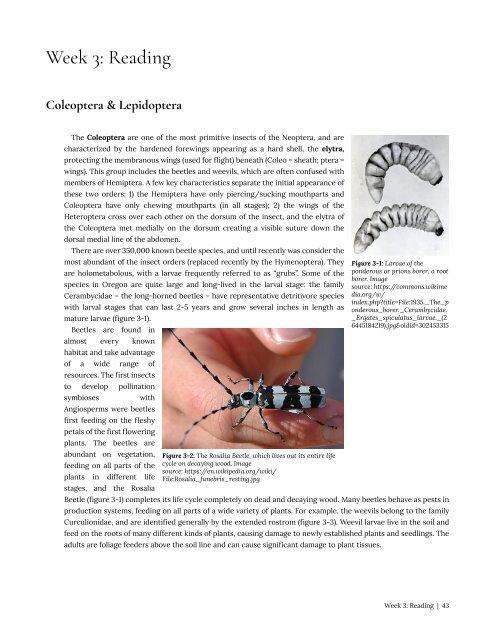Entomology 311 Lab Manual - 1st Edition, 2019
Entomology 311 Lab Manual - 1st Edition, 2019
Entomology 311 Lab Manual - 1st Edition, 2019
You also want an ePaper? Increase the reach of your titles
YUMPU automatically turns print PDFs into web optimized ePapers that Google loves.
Week 3: Reading<br />
Coleoptera & Lepidoptera<br />
The Coleoptera are one of the most primitive insects of the Neoptera, and are<br />
characterized by the hardened forewings appearing as a hard shell, the elytra,<br />
protecting the membranous wings (used for flight) beneath (Coleo = sheath; ptera =<br />
wings). This group includes the beetles and weevils, which are often confused with<br />
members of Hemiptera. A few key characteristics separate the initial appearance of<br />
these two orders: 1) the Hemiptera have only piercing/sucking mouthparts and<br />
Coleoptera have only chewing mouthparts (in all stages); 2) the wings of the<br />
Heteroptera cross over each other on the dorsum of the insect, and the elytra of<br />
the Coleoptera met medially on the dorsum creating a visible suture down the<br />
dorsal medial line of the abdomen.<br />
There are over 350,000 known beetle species, and until recently was consider the<br />
most abundant of the insect orders (replaced recently by the Hymenoptera). They<br />
are holometabolous, with a larvae frequently referred to as “grubs”. Some of the<br />
species in Oregon are quite large and long-lived in the larval stage: the family<br />
Cerambycidae – the long-horned beetles – have representative detritivore species<br />
with larval stages that can last 2-5 years and grow several inches in length as<br />
mature larvae (figure 3-1).<br />
Beetles are found in<br />
almost every known<br />
habitat and take advantage<br />
of a wide range of<br />
resources. The first insects<br />
to develop pollination<br />
symbioses<br />
with<br />
Angiosperms were beetles<br />
first feeding on the fleshy<br />
petals of the first flowering<br />
plants. The beetles are<br />
abundant on vegetation,<br />
feeding on all parts of the<br />
plants in different life<br />
stages, and the Rosalia<br />
Figure 3-2: The Rosalia Beetle, which lives out its entire life<br />
cycle on decaying wood. Image<br />
source: https://en.wikipedia.org/wiki/<br />
File:Rosalia_funebris_resting.jpg<br />
Figure 3-1: Larvae of the<br />
ponderous or prions borer, a root<br />
borer. Image<br />
source: https://commons.wikime<br />
dia.org/w/<br />
index.php?title=File:1935._The_p<br />
onderous_borer._Cerambycidae.<br />
_Ergates_spiculatus_larvae._(2<br />
6445184219).jpg&oldid=302453315<br />
Beetle (figure 3-1) completes its life cycle completely on dead and decaying wood. Many beetles behave as pests in<br />
production systems, feeding on all parts of a wide variety of plants. For example, the weevils belong to the family<br />
Curculionidae, and are identified generally by the extended rostrom (figure 3-3). Weevil larvae live in the soil and<br />
feed on the roots of many different kinds of plants, causing damage to newly established plants and seedlings. The<br />
adults are foliage feeders above the soil line and can cause significant damage to plant tissues.<br />
Week 3: Reading | 43


















